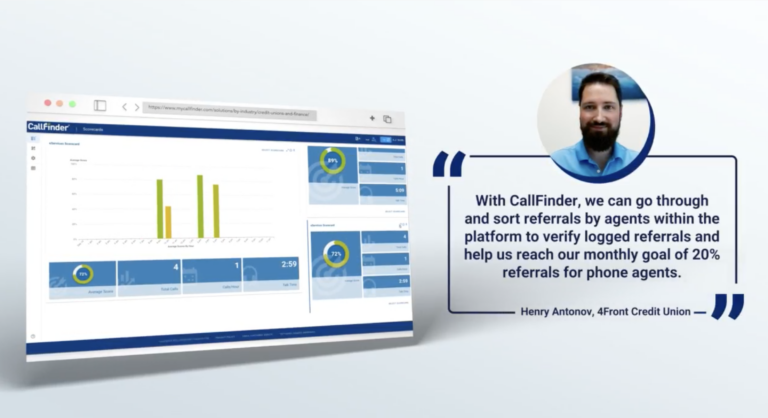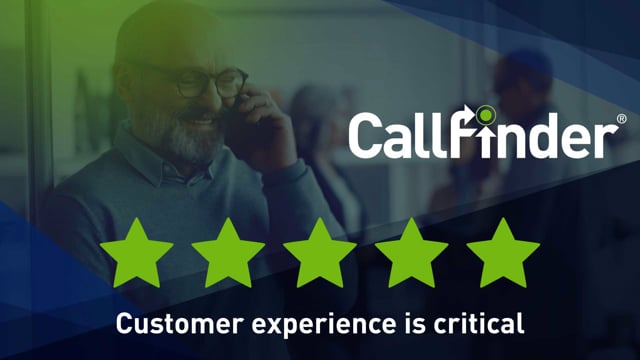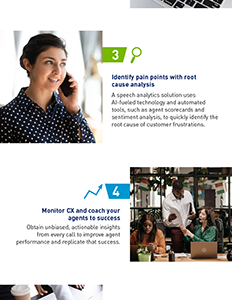Customer experience (CX) is considered the key differentiator between one organization and another. Providing the best possible experience to your customers gives you a competitive advantage over the rest of the market, regardless of your industry.
That said, no CX strategy is complete without an effective customer service team. As specialists on the frontline of almost every customer-brand interaction, agent performance is a critical factor in delivering quality experience at every possible touchpoint.
Customer experience is so important, according to PwC data, that 59% of Americans will abandon a brand – even one they love – after several bad experiences. While 17% would do this after just one poor interaction, that number leaps to 32% for customers around the world.
These numbers indicate the obvious: Customer experience truly matters. That’s why every organization stands to benefit from improving CX throughout the customer journey. But how do companies ensure their strategies are working?
To answer this question, you’ll need to know the ins and outs of customer lifetime value (CLV).
What does customer lifetime value actually mean?
Customer lifetime value is an integral part of any worthwhile customer experience program. CLV is a statistic that tracks a customer’s value to your business – not just at one time, but for the entirety of that relationship.
Put simply, it’s a good way to quantify how much income customers provide over the duration of doing business with your company. But how does CLV relate to the customer experience?
Because CLV measures the relationship between customers and the brand, you can extrapolate this to measure success. It indicates how effective your customer service strategy is at improving customer experience. A quality CX strategy, in turn, leads to a longer, more valuable relationship with your customers.
Boosting gross margins through CLV
CLV affords you the opportunity to monitor the customer experience and develop new strategies for customer acquisition and retention. Moreover, because CLV is tied directly to revenue, it’s also an effective way to gauge the profitability of your investments into a customer or demographic. This gives you the chance to reallocate your marketing efforts in other areas.
In other words, CLV helps you decide how much is worth spending to acquire a new customer. If customer acquisition costs exceed lifetime value, you’ll know the investment isn’t worth your time or money. More often than not, acquisition is costlier than retention. For this reason, measuring CLV is a vital asset for improving customer loyalty and the overall experience.
The challenges of traditional customer metrics
Customer lifetime value is just one of many metrics that measure the customer experience. In addition to CLV, there’s a wide variety of traditional measurements, including:
- CSAT score: A customer satisfaction score (CSAT) is just like it sounds – a measurement of how satisfied a customer is with their experience. These scores are usually obtained from surveys or questionnaires at the end of a customer interaction. Questions typically ask respondents to rate their experience on a scale from least to greatest satisfaction.
- Net Promoter Score (NPS): In contrast, this is a measurement of customer loyalty that’s usually obtained through a single-question survey. Traditionally, that question asks the customer to rate how likely they are to recommend the company to a friend. In doing so, they classify respondents as detractors, passives, or promoters.
Although useful in their own right, CSAT scores and NPS fall short of putting the customer experience into perspective. NPS, for example, can lead to problematic assumptions about consumers. In fact, according to research by Harvard Business Review, 52% of all people who reportedly discouraged others from a brand had also actively promoted it. Researchers later discovered that how, when, why or to whom customers recommend or criticize a product is more fluid than an NPS might indicate.
Likewise, CSAT scores are also problematic. Surveys rely on self-reported data, meaning that they’re swayed by personal and cultural bias. Customer satisfaction means something different to every customer and doesn’t take sentiment or context into account. Additionally, CSAT scores have an average response rate of around 15%, per Customersure. Because few people actually complete surveys, the data collected is inaccurate and produces few – if any – actionable insights.
Indeed, there’s a much better way to monitor customer experience. Customer lifetime value, by comparison, isn’t dependent on self-reported surveys or limited by a questionnaire. CLV is mathematical in nature and therefore much more reliable than traditional methods. Better yet, because CLV is tied to revenue and can be applied both broadly and granularly, businesses can obtain many actionable insights.
Pros and cons of customer lifetime value
For companies hoping to improve the customer experience, measuring CLV is an important first step. By taking on a CLV-oriented customer acquisition and retention strategy, you and your customer service team are empowered to make the most of every interaction.
Let’s take a look at how you stand to benefit from calculating customer lifetime value:
- It helps you foster brand loyalty: CLV is all about making recurring contact with customers. In doing so, you can build a greater relationship to the brand and give customers a reason to come back for more. CLV is also a useful tool for predicting customer churn. If a customer or demographic has a low CLV, they are more likely to abandon the brand.
- You can predict profitability: Because CLV is a calculation of a customer’s approximate worth to a company, the business can use it to gauge profitability. The higher the CLV, the greater the impact on your bottom line.
- CLV saves you money in the long run: Customer acquisition costs today are often far greater than the cost of retention tomorrow. By focusing on increasing the customer retention rate, you not only maximize the value of existing customers, but you also avoid the cost of replacing them with new ones.
- It’s a much more sustainable approach: Focusing on CLV orients your company in a data-driven direction. Investing in your customers for the long term allows you to proactively improve their experience throughout the customer lifespan. Just by answering questions related to purchase frequency, nurturing and retention will help you identify more effective strategies.
- CLV allows you to put targeted demographics into segments: No two segments are exactly the same, which is why it’s so important to understand each one individually. CLV allows you to closely monitor the customer experience for each segment and make targeted adjustments.
- It’s easy to calculate: Not only is the typical CLV formula simple; it requires basic data that most organizations should have on hand. Better still, you can calculate CLV by segment or individual customer. This helps you get a more accurate read on lifetime value as it relates to different demographics or individuals.
All that said, no metric is perfect. Even CLV comes with disadvantages to consider:
- It isn’t a perfect prediction: As a best-guess metric for customer equity, CLV only takes you so far. You can’t take it for face value, but you can keep it in mind when you’re evaluating and making adjustments to customer experience strategies.
- Many variables impact CLV: Customers are influenced by many things. Marketing campaigns, customer service interactions, and even competing brands are relevant factors. Any number of things could sway customer loyalty in one direction or another and change their CLV. In turn, you can’t always know which actions are directly related to an increase or decrease in value.
How do you calculate customer lifetime value?
Generally, customer lifetime value is easy to calculate. Consider a basic example:
Let’s say you purchase a $20 cake from the same bakery once a year for five years. For the duration of your relationship to the bakery, your lifetime value has been $100. Simple, right?
Of course, larger companies have many more moving parts to take into account. With the right information at your disposal, you can calculate historic lifetime value at three different levels:
- Company-wide
- By customer segment
- By individual customer
The CLV formula, by extension, grows a bit more complicated at each of these turns.
Before diving into each, you’ll need the relevant data on hand. Here’s what you need to calculate CLV:
- Average order value (AOV): This is how much money your customer(s) spends on average over a determined time period.
- Average purchase frequency (F): This is the number of purchases your customer(s) made over a period of time divided by the total number of individual customers who made a purchase during that period.
- Customer value: Determine this number by multiplying AOV and F.
- Average customer lifespan: This is on average the duration of time a customer continues buying from your company.
Calculating general company-wide CLV
At the most basic level, CLV is calculated to broadly determine the profitability of your customer’s relationship to the company. With the data outlined above, let’s put the basic formula together:
General CLV = Customer value X average customer lifespan
This formula uses historical data to help you answer a vital question: How much money can I expect the average customer to spend over the course of our relationship? As a result, you’re able to better monitor your customer experience strategy at-large. In turn, you acquire a more accurate understanding of ROI as it relates to obtaining a new customer versus retaining an existing one, thus allowing you to optimize investments in each.
Calculating CLV by segment
It must be noted that not all customers are created equal. For this reason, it’s important to tweak the CLV formula to account for those differences.
To calculate CLV by segment, you’ll need to first break down your customers. Once you’ve segmented your customer base by your chosen segmentation strategy – by demographic, behavior, etc. – you can use the same CLV formula. This time, however, you’ll input only the data specific to each segment.
You may find that one segment has a higher CLV than another – an indication that the latter group isn’t quite as profitable. If their customer acquisition cost exceeds their CLV, an investment in that segment wouldn’t make sense.
Calculating CLV by individual customer
Individual CLV is perhaps most beneficial in the contact center where agents are speaking directly with each customer. To calculate CLV by individual customer:
Individual CLV = Customer revenue per year X duration of relationship – cost of acquisition
Having this metric ready helps agents determine how far they’re willing to go to retain the customer’s loyalty. Individuals with higher CLV are likely better investments than those with low CLV.
How to improve CLV in your organization
Whether your goal is to acquire a new customer or strengthen your bond with existing ones, improving CLV all comes back to the customer experience.
Of course, customer lifetime value is only as good as your CX strategy. The more effective your strategy, the more likely your investments will cascade into a greater CLV. That’s why it’s important for your organization to optimize experience at every touch point – especially in the call center.
With a speech analytics solution, you’re empowered to achieve exactly that. Here are a few ways speech analytics can improve CLV in your organization:
Coach your agents
AI-fueled speech analytics technology automatically generates unbiased scorecards that help you objectively monitor CX and improve agent performance. Calls are automatically scored based on your chosen criteria for success, allowing you to coach agents to more positive outcomes.
In turn, you can improve training materials and replicate success throughout the call center. Coaching and retraining agents through speech analytics goes a long way toward improving CX and, by extension, customer lifetime value.
Identify pain points
Automated tools, such as sentiment analysis, scan calls for words and phrases that define and segment a customer’s mood during conversations. Similarly, emotion detection analyzes acoustic data to determine where call outcomes lie on a range from negative to positive.
Along with silence & overtalk detection, which helps you get to the source of customer pain points, these tools enable you to improve CX using root cause analysis.
Put every call into context
From speech-to-text transcriptions and automated scorecards to sentiment analysis and emotion detection, call centers can easily monitor and improve customer experience using a speech analytics solution. In combination with other tools, speech analytics technology segments and categorizes calls by sentiment, emotion, overtalk, silence, and even phrases indicating customer frustration during the conversation.
Moreover, speech-to-text transcriptions are searchable documents that help you quickly locate and dig into the context of certain calls, providing a better understanding of every aspect of the interaction, including the outcome. In turn, quality assurance managers can make better decisions on how to improve agent performance and optimize CX.
With a robust suite of automated tools, speech analytics helps you provide your customers with the seamless, positive experience they expect. Better yet, they empower you to maximize their value for the duration of your relationship.
To learn more about how CallFinder’s speech analytics solution can improve customer lifetime value at your company, schedule a 15-minute demo today.





